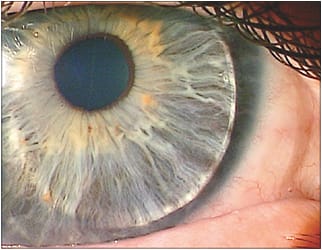CLINICAL
CONTACT LENSES
INVEST IN KERATOCONUS
OFFER SUPERIOR SERVICE BY BECOMING AN EXPERT IN FITTING THESE PATIENTS
JASON R. MILLER, O.D., M.B.A., F.A.A.O.
CUSTOM CONTACT lens fitting, specifically for patients who have unique ocular anatomy and visual demands, is an important service that we can provide. Our patients with keratoconus are a perfect example of this patient population. These patients may have been told they cannot wear contact lenses or may have given up on contact lens wear altogether because of discomfort or a fitting issue. Offer superior service by becoming an expert in fitting these patients.
GAIN SKILLS
Consider these steps:
• Attend a CE on keratoconus at the next conference you attend. This provides an opportunity to potentially learn a new fitting technique, new lens design or new research that can aid you in lens selection.
• Add another fit set, which can enhance your offerings for this unique group of patients. It could be a new soft lens, hybrid, RGP or scleral lens design. Any of these would add something new to your “toolbag” of lenses for patients who have been diagnosed with keratoconus.
• Recruit “cheerleaders” from your staff. Do this by celebrating your successes. During your next staff meeting, discuss a unique keratoconus patient and his or her success with your contact lens fitting. This acknowledgement provides staff with an anecdote about your skills to discuss with current and prospective patients.
An example of a recent successful kerataconic fitting consisted of a patient who had previously never been able to wear contact lenses. He was a new patient to my office and had heard about us from a friend. Because of his previous failures with RGPs, I utilized a soft, keratoconus contact lens design. The variable lens center thickness in this design is used to neutralize the corneal irregularities in these patients.

The center optic zone of this design is apparent in the photo.
• Finally, make sure everyone understands the unique billing steps for this specific custom contact lens fitting. For example, a patient has an exam, is diagnosed with keratoconus and is fit with contact lenses. At the first visit, an exam is billed, along with 92072 and corneal topography. Code 92072 includes only the initial fitting. This patient has another appointment to have the lenses dispensed and requires two subsequent follow-up visits. You then need to bill the subsequent visits using the 99xxx or 92xxx depending on what the patient qualifies for in terms of his or her benefit coverage.
SOLVE PROBLEMS
There are many unique platforms, such as an RGP lens or a hybrid lens, and designs that allow the contact lens practitioner to provide a differentiated product to his or her keratoconus patients. Set your services apart by providing these patients with new and innovative solutions.
Consider investing in these steps to improve the contact lens care you provide. It may not only save you time, but also increase revenue in the long run. OM

| DR. MILLER is a partner at Eyecare Professionals of Powell, in Powell, Ohio, on the board of the Ohio Optometric Association and is an adjunct faculty member for The Ohio State University College of Optometry. To comment on this article, visit tinyurl.com/OMcomment. |



